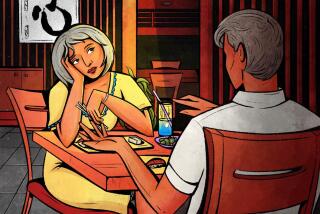How to Keep a Mate With Fantasy
NEW YORK — It’s 1 a.m. Sunday morning. Your VCR ejects “Pelle the Conqueror,” an epic film about the meaning of life.
Tears are still rolling down your face when the TV screen fills with the image of Ellen Kreidman, a helmet-coiffed blond, extolling the meaning of life, or how to keep your man passionately and hopelessly in love with you.
She’s the author of the best selling “Light His Fire,” published in September.
Just when you think you’ve got some fix on the meaning of life, here’s Kreidman, in a paid 30-minute TV advertisement, telling you the way to keep a man is to kidnap him from work, handcuff him, wear stick-on bows and nothing else, practice baby-talk and compliment him extravagantly.
When you tell him, for instance, “I wouldn’t trade any other man for you,” and he replies, “What about Tom Selleck?” you throw your arms around him and say--convincingly--”He doesn’t hold a candle to you.”
In other words, do or say anything to keep this relationship going because, according to Kreidman, “if he doesn’t have an affair with you, he’ll have an affair with somebody else.”
In a New York hotel room before her recent appearance on Phil Donahue’s show, Kreidman, dressed in kelly green with shoes that look dyed to match and earrings the size of clamshells, says: “A man falls in love with a woman because of the way he feels about himself when he’s with her.
“Women don’t have to get any more intelligent. Or attractive. They don’t have to lose weight. They just have to be very loving and supportive.”
Very nice. Very logical. Kreidman, a petite Size 6, admits, “I don’t think I’m very attractive.”
When she was born 45 years ago, her German-Jewish refugee father saw her and said, “She’s got big ears.”
It took a long time, but Kreidman got over it. “I’m with someone now who thinks I’m the most beautiful woman in the world,” she says. “That’s what’s really important.”
Is she the Total Woman reincarnated? Is she a throwback to the 1950s when women were doormats and men wiped their shoes all over them? Wasn’t feminism supposed to end all this?
Feminist and Washington psychologist Karen Shanor observes, “It’s back to the 1950s. It’s Marabel Morgan revisited. It’s back to being half a person looking for your other half.”
The current self-help bookshelf for women is crowded with perhaps 500 new titles a year, and the spectrum runs from “How to Be the Cutest Doormat” to “How to Work on Communication and Self-Esteem.”
This book, according to Shanor, falls somewhere in between.
“There are some interesting ideas and suggestions, and I don’t disagree with learning to be more playful in a relationship,” she says, “but I don’t like the tone of the book. It comes across as advice for women training a puppy dog instead of dealing with another human being.”
Peggy Vaughan, author of “The Monogamy Myth,” debates the premise of the book, based on her own experiences.
When she suspected her husband might be having affairs, she played all the games, she says. “I fixed myself up, made gourmet meals, tried everything.”
In her case, it backfired: “My husband had the best of both worlds, the wife and the mistress.”
Her advice: “You can’t do anything to prevent your spouse from having affairs except by being in an honest, open relationship.”
Kreidman tells a story. “I was terrified before this book came out. I sat around worrying that I when I wrote all this stuff--about the baby talk and pet names, women catering to men--that I would travel around the country and be crucified by the feminists. That I would be constantly defending myself from all that.”
Before her book tour, on a trip to her gynecologist--a Los Angeles feminist--she spoke of her fears.
The gynecologist had read the book and admitted she loved it. “And she said to me, ‘Ellen, we don’t have to worry. We’re smarter than the (‘70s) feminists.’ ”
“Women are done fighting,” she says. “We now have the total freedom to do what we want to do. . . . Women want to have fun again, and it has nothing to do with feminism.”
Kreidman maintains that her friends who are feminists and married liked the book.
It’s those other women--read unmarried--who are threatened by it.
But for the record, Shanor, the psychologist, is a Mrs. who says, “I’m very happily married, and my husband and I both find books like this insulting and dehumanizing.” And Vaughan, the author, has been married for 34 years, the marriage stronger than ever despite infidelities.
Yet, Kreidman complains about all the other self-help book writers “who write about happy relationships, and you look at their lives and it’s nothing but heartbreak . . . three divorces. What do they know?”
“You want advice, you go to the experts,” says Kreidman, in a voice that betrays her native New York City. “Who better to give advice than me? I’ve been married happily for 22 years.”
But it was not always so.
The two young sweethearts married in the mid-1960s and moved from New York City to California, where hubby Stephen was in sales. At first they had a very comfortable life style complete with household help, but hubby lost his job and the family neared bankruptcy in 1971.
Her epiphany: “I was at a stop light. And here I was a mother of a small child with another on the way. We were totally broke, my mother-in-law was coming to live with us. And I was sobbing. Asking myself, ‘Is that all there is to life?’ And there was a little voice inside me, and I’m not religious or anything, but the little voice said, ‘Yes, Ellen, That’s all there is. For things to change, you must change.’ ”
Kreidman enrolled in the Life-Is-Short school. Be Here Now. Live for Today. She had to rescue her marriage. Fast.
No doubt about it, Kreidman practices what she preaches. One Valentine’s Day she sent a Gorillagram to her husband, who now works in computer sales and was attending a seminar at a nearby hotel. She also checked herself into the hotel. The gorilla delivered this note to her husband: “When you get through come to Room 555, so we can monkey around. I’m just ape over you.”
When she wasn’t keeping hubby happy, she was working as a schoolteacher, using her combined bachelor’s degree in psychology and education from Queen’s College in New York City. She was also dreaming of how to teach other women what she knew about men.
(Her husband stays in the background and doesn’t grant interviews.)
In 1981, she started teaching small seminars called Light His Fire in Orange County, where she lives. And women signed up for her advice, paying $250 for six two-hour sessions.
“The women really helped me write this book,” she says.
There were plenty of surprises along the way.
“The most beautiful Vogue cover girl would come in and she wouldn’t have had a relationship for years,” Kreidman says. “And then this really homely, overweight woman would come in and say she was dating three men and needed to choose one of them to marry.”
The women also shared their experiences and told the groups how they play games. They litter love notes all over Southern California. They practice 51 ways to keep their men happy ranging from No. 1 (send him on a love hunt) to No. 51 (charter a sailboat for the night).
On Page 122 of her book, Kreidman faces up to the resistance to such schemes.
“Some of you are probably wondering why the responsibility for romance falls on your shoulders. ‘Why is it always the woman?’ you ask. The answer is because most men have never learned how to be romantic. They need to be taught.”
And the way to teach is through example.
“I’m not saying anything new in this book,” says Kreidman. “These are things that just need to be said over and over again.”
More to Read
Sign up for The Wild
We’ll help you find the best places to hike, bike and run, as well as the perfect silent spots for meditation and yoga.
You may occasionally receive promotional content from the Los Angeles Times.






